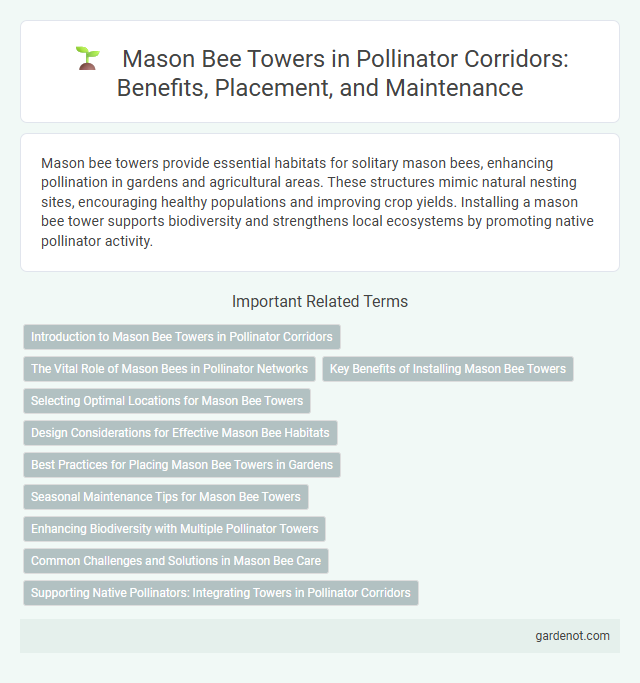Mason bee towers provide essential habitats for solitary mason bees, enhancing pollination in gardens and agricultural areas. These structures mimic natural nesting sites, encouraging healthy populations and improving crop yields. Installing a mason bee tower supports biodiversity and strengthens local ecosystems by promoting native pollinator activity.
Introduction to Mason Bee Towers in Pollinator Corridors
Mason bee towers serve as essential habitats within pollinator corridors, providing nesting sites for solitary mason bees known for their efficient pollination of fruit trees and native plants. Constructed from environmentally friendly materials with multiple small cavities, these towers support the reproduction and survival of mason bees, enhancing local biodiversity and crop yields. Strategically integrating mason bee towers in pollinator corridors contributes to sustaining pollinator populations critical for ecosystem health and agricultural productivity.
The Vital Role of Mason Bees in Pollinator Networks
Mason bees contribute significantly to pollinator networks by efficiently pollinating a wide variety of plants, enhancing biodiversity and crop yields. Their solitary and non-aggressive nature allows them to thrive in urban and rural environments, making them reliable pollinators throughout the growing season. Mason bee towers provide essential nesting habitats that support population growth and sustain local ecosystems.
Key Benefits of Installing Mason Bee Towers
Mason bee towers provide a vital habitat for native mason bees, enhancing local pollination efficiency by supporting their solitary nesting habits. These structures increase crop yields and garden productivity by promoting the pollination of fruit trees, vegetables, and flowers. Installing mason bee towers also contributes to biodiversity conservation and supports ecosystem health by bolstering populations of these effective pollinators.
Selecting Optimal Locations for Mason Bee Towers
Selecting optimal locations for mason bee towers involves identifying sunny, sheltered spots with proximity to diverse flowering plants that provide abundant pollen and nectar. Ideal placement is near native vegetation and water sources, avoiding areas with heavy foot traffic or pesticide exposure to ensure bee health and activity. Elevating the tower 3 to 6 feet off the ground enhances protection from predators and facilitates mason bee navigation.
Design Considerations for Effective Mason Bee Habitats
Mason bee towers should prioritize natural materials like untreated wood and hollow reeds to mimic native nesting sites, enhancing adoption rates. Structural design must ensure protection from predators and weather, with adequate ventilation and drainage to prevent mold and parasitic infestations. Positioning the tower in a sunny, sheltered area near diverse flowering plants optimizes pollination efficiency and supports robust Mason bee populations within the corridor.
Best Practices for Placing Mason Bee Towers in Gardens
Position Mason bee towers in locations receiving morning sunlight and afternoon shade to maintain optimal temperature and prevent overheating. Place towers near native flowering plants within 300 feet to ensure easy access to diverse pollen sources, enhancing mason bee pollination efficiency. Elevate towers at least three feet above ground level to shield from predators and moisture, ensuring longevity and bee safety.
Seasonal Maintenance Tips for Mason Bee Towers
Regular seasonal maintenance of Mason bee towers enhances pollinator health and longevity by ensuring clean nesting materials and preventing mold buildup. Removing old cocoons in late fall promotes healthy overwintering and reduces parasite risks, while replacing damaged or wet nesting tubes during early spring supports successful bee emergence. Proper site placement with ample sunlight and shelter from heavy rainfall optimizes the tower's functionality throughout the pollination season.
Enhancing Biodiversity with Multiple Pollinator Towers
Mason bee towers play a crucial role in enhancing biodiversity by supporting a variety of solitary bee species essential for pollination. Strategically installing multiple pollinator towers in urban and rural landscapes creates interconnected habitats that boost native plant reproduction and ecosystem resilience. Research indicates that diverse pollinator populations help sustain agricultural productivity and promote overall environmental health.
Common Challenges and Solutions in Mason Bee Care
Mason bee towers often face challenges such as nest parasite infestations, improper moisture levels, and habitat disruption. Effective solutions include regularly cleaning nesting tubes, ensuring proper ventilation to prevent mold, and situating towers in sheltered locations with abundant native forage. Monitoring bee activity and replacing damaged materials annually also supports healthy mason bee populations.
Supporting Native Pollinators: Integrating Towers in Pollinator Corridors
Mason bee towers provide essential nesting habitats that support native pollinators within pollinator corridors, enhancing biodiversity and ecosystem resilience. These structures boost local populations of solitary bees, such as Osmia species, which are highly efficient pollinators for fruit trees and wildflowers. Integrating mason bee towers strategically into pollinator corridors ensures continuous floral resources and nesting sites, promoting sustainable pollination services throughout the landscape.
Mason bee tower Infographic

 gardenot.com
gardenot.com